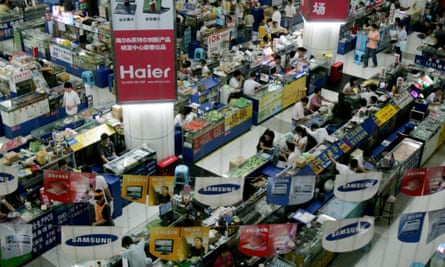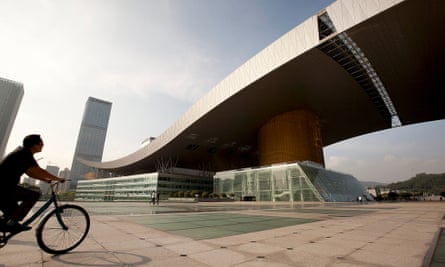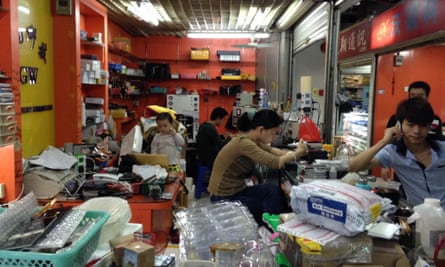Everywhere you look, there is enterprise. Inside the Huaqiangbei electronics markets of Shenzhen, every booth on all 10 floors represents a factory somewhere in southern China’s Pearl River Delta megalopolis. The rep will sell you one tiny component or a hundred thousand, to be delivered to your factory within a week. At the end of each day, aisles are blocked with cardboard boxes and the markets fill with the sound of ripping parcel tape, as packages are sealed and despatched into fleets of vans waiting outside.
In the streets and lifts of nearby office blocks, everyone seems to be carrying reels of old-fashioned tape recorder spools. In fact, these contain tiny components embedded in paper tapes, with 16,000 LED lights on each. The tapes are fed into ‘pick-and-place’ robots to make the electronic circuit boards that are key to Shenzhen’s fortunes.
To outside observers, this city of 10-15 million may look like another baffling Chinese metropolis. But for a small global community of hackers and entrepreneurs, this is a technological nirvana – a vibrant, multi-coloured landscape of possibility, opportunity and creative exploration.
“Everything you need is here,” says Eric Pan, founder of Seeed Studio, looking out of the dusty windows of his mid-rise office/factory/warehouse. Within walking distance of his building are circuit-board manufacturers, injection-moulding companies, packagers and shippers. He is three hours from factories making every imaginable electronic component, and three days by FedEx from 90% of the world’s population.
In Shenzhen, you have everything you need to turn a sketch on a napkin into 100,000 smartwatches, bike lights or drones, all shipped to Amazon or Argos in time for Christmas 2014. At least, that’s the dream for a new generation of hardware startups.

Twenty years ago, digital tools made it possible to build internet businesses with minimal costs; a company like Facebook could launch from a dorm room without any major investment. Hardware was different, though, the domain of corporate labs and R&D budgets. Now that’s changed, and making a proof-of-concept for an internet-connected doorbell or GPS-enabled tennis racket is a weekend project for the right kind of geek.
Hi-tech entrepreneurs are having an idea, building a prototype, making a convincing promotional video, then posting it to the world on Kickstarter. If the idea catches fire, the founders may find themselves with a few hundred thousand dollars in the bank, a prototype, and a host of excited customers to satisfy. Which is when – often – they make the pilgrimage to Shenzhen to meet manufacturers and suppliers face to face. They’ll rent an apartment, learn a few words of Chinese, and likely apply for a tech incubator scheme such as HAXLR8R.
The HAXLR8R office, on the 10th floor of a tower block near the Huaqiangbei electronics markets, resembles most startups – whitewashed walls and scavenged furniture - but with added extras: soldering irons and component sample books on the benches; access to laser cutters and 3D printers, not to mention your very own pick-and-place robot.
One bench houses Helios, a startup from Sacremento, California, which makes smart handlebars for bikes with built-in GPS, Bluetooth and a lot of LEDs. Helios came to Shenzhen with an idea, finished the design and launched on Kickstarter with an uplifting promo video, raising $120,000 in pre-orders. It’s a phenomenally complicated product, involving heavy-duty metalwork, precision-moulded plastic components, radio signals from space and apps for your smartphone. The updates on the Kickstarter page are a catalogue of little disasters and triumphs: broken moulds, patchy GPS reception, interminable Chinese holidays and, finally, huge stacks of boxes ready to ship.
The mood here feels a little like the pre-boom internet of the late 1990s: a lot of excitement and a few big deals – Google, Apple and Facebook have all purchased hardware companies with billion-dollar valuations in the last six months. By riding the wave, Shenzhen hopes to become the Silicon Valley of the world’s hardware startups.

Thirty years ago the city didn’t exist, barring a few fishing towns along the coast. In 1979, it was declared a Special Economic Zone (China’s first) and surrounded by an 85-mile, barbed-wire fence. Investment and migrant workers flooded the area, and factories and housing were built from scratch. By the mid-90s, the population of Shenzhen had climbed to 3 million, and its Window On The World theme park had opened with one-third-scale reproductions of the Eiffel Tower and 130 other world monuments.
Today, Shenzhen’s permanent population is around 10 million, rising to 15 million during the summer-autumn electronics season, when the hardware plants expand to build the world’s Christmas electronic gifts. Construction is evident everywhere here. The first metro station opened in 2004; now there are 131 stations, with three new lines being built simultaneously.
This dizzying growth is under threat. In 1988, the Taiwanese electronics manufacturer Foxconn opened a factory in Shenzhen. Twenty years later, it had grown to up to 400,000 employees, producing hundreds of thousands of Apple products every day. Then came what Chinese call the Foxconn-Apple “suicide crisis” of 2010. The bad press and global attention came as a huge shock for the company, and the following year it moved 300,000 jobs away from Shenzhen, 1,000 miles north to a plant in Zhengzhou that can produce 200,000 iPhones a day.
But as these low-paid jobs move inland, or to other Foxconn bases in eastern Europe and Mexico, so Shenzhen has recognised the need for change; to move up the value chain into design, branding, marketing and retail. The city now boasts a ‘maker space’, a design district, and a collaboration with London’s V&A to open a design museum in the Shekou district, where the largest Maker Faire in China was held in April.
But perhaps the city’s best hope for a design-led future comes from an unlikely source. In the 1990s, Shenzhen filled up with markets, factories, entrepreneurs and skilled workers, and some of those resources found their way into the underground culture of shanzhai – copycat electronics. In the early 2000s it was fake MP3 players and Polystation games consoles, but in due course smartphones also proved perfect for shanzhai manufacture – some estimates put their current share of the global mobile phone shipment market at 25%. The phones that fuelled the Arab spring were soldered in the back streets of Shenzhen.

Despite their disregard for intellectual property laws and safety testing, the culture of the shanzhai manufacturers is modern and collaborative. Design files are shared, with each maker contributing to the pool of knowledge. Chinese component manufacturers spend R&D money to develop gongban - publicly available designs for products such as smartphones, tablets and smart watches. They’re designed to fit into gongmo - the equivalent public designs for cases and enclosures. With a gongban, a gongmo, a few reels of components and access to factories, you can produce a professional – if rather generic – electronic product.
Shanzhai manufacturers have learnt to to cut all the fat out of their business. According to Lyn Jeffery of the Palo Alto-based Institute for the Future, they might break even on a phone that sells only 10,000 units – enabling them to innovate wildly and build specialised products for specific markets – even for different cities. Working together, it appears that international hardware startups – with their innovation, marketing and branding skills – and the shanzhai talent pool – supplying limitless reserves of hustle – might offer a formidable challenge to traditional, less nimble consumer electronics companies.
This is where Eric Pan comes in. The 30-year-old founder of Seeed Studio is a Forbes China magazine cover star and a living embodiment of the Shenzhen dream. Pan grew up in Sichuan, studied electrical engineering and briefly working for Intel in Beijing. Then he went to Shenzhen for a weekend, walked into the Huaqiangbei electronics market, and realised this was his destiny.
“I called my room-mate, told them to put everything in a box and send it down here,” Pan recalls. Having started a business from his apartment, he now employs 150 people with a turnover of around $10m. He describes Seeed as an “open hardware facilitator” – if you have an idea for a quirky product, he can help you make it. (Even the mighty Foxconn has joined the party by launching Innoconn, an incubator based in an empty Nokia manufacturing space in Beijing.)
Despite the considerable efforts of Pan and others like him, the connections aren’t all in place in Shenzhen – yet. No international hardware startup has made the journey from a Huaqiangbei booth to a stock-market listing. But the tools are there.
Tom Whitwell is a digital consultant working with the British Council's Creative Economy programme, which connects creative pioneers through international initiatives such as Playable City and Unbox

Comments (…)
Sign in or create your Guardian account to join the discussion